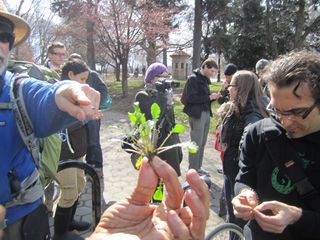Which Type Of Organelle Is Found In Plants But Not In Animals
Jump Shows Earlier and Earlier for Many Plants, Animals

NEW YORK — A tiny, cloverlike plant with centre-shaped leaflets caught Steve Brill's attention as he scanned the ground of a Brooklyn park.
"We have really messed up our climate if this plant, which dies in November, is alive now," Brill appear as he introduced the plant, xanthous wood sorrel, to the group following him.
Brill leads foraging tours for edible plants in the New York expanse, and his kickoff tour of the 2012 season, in Prospect Park, yielded some surprises brought by the unusually mild winter. The lemony-flavored sorrel, for instance, had shown upward at least a month earlier than normal.
Sunday (March 4) marked the first bout of his 30th season. Brill said he has noticed a gradual shift in the annual cycle over the years, with many plants showing up nigh 3 weeks before than they once did, and so lasting much longer. This year is unprecedented — some plants never even died off for the wintertime, he said. [Gallery: Signs of Early Spring in Brooklyn]
Changes in timing
Scientific show for like shifts in timing amidst all kinds of plants and animals is abundant. For example, studies indicate lilacs in North America are leafing out and flowering before; in Japan, gingko trees are getting their commencement leaves earlier and losing them later; bee species in the northeastern North America are emerging before, keeping pace with the flowers upon which they feed; British butterflies are also showing upward sooner; and birds appear to be shifting the timing of their migrations.
I written report even looked at National Park omnipresence to notice testify of a similar shift in seasonal timing — called phenology — for humans.
"At that place is a report coming out every week showing changes are occurring," said Jake Weltzin, the executive managing director of the U.s.a. National Phenology Network and an ecologist with U.Southward. Geological Survey, which recruits volunteers to monitor seasonal changes in plants and animals.
Attributing these changes straight to global climate change is more difficult, simply researchers are beginning to do just that; they're finding show that shifts in climate are directly linked to changes in the timing of biological events, Weltzin said.
Consequences
Changes in the timing of events such as spring blooms, insect emergence and bird migrations accept consequences.
Outset of all, not all species reply in the aforementioned way; some are better able to adapt than others. This means mismatches tin occur, if, say, bees and the flowering plants they pollinate don't respond at the same charge per unit. Mismatches similar this can touch on the prospects of the species involved.
"It is going to rig the game for certain species and the ones that are successful, it is going to change the individuals inside them," said Mark Schwartz, a distinguished professor of geography and climate at the University of Wisconsin-Milwaukee. "Information technology is an evolutionary process."
The fingerprint of climate change
Schwartz studies how plants answer to changes in seasons and climate, drawing upon observations of plants fabricated by volunteers. With records of the first appearance of their leaves and flowers going back to 1956, lilacs — all of which are genetically identical to minimize variation among them — accept the longest record.
Using observations from the lilacs, also as cloned honeysuckle, Schwartz has built models to fill in the gaps in the data to predict how temperature might affect the arrival of leap leaves and blooms.
Using this technique, Schwartz and colleagues take shown that first leafage and blossom dates crept alee by effectually one mean solar day per decade between 1955 and 2002 across almost Northern Hemisphere temperate regions. Other studies that have assessed data on many species have also plant temperature-related shifts in spring.
His spring constitute models have too been used to look at how natural patterns, such as cycles in atmospheric pressure and ocean temperature, play into earlier springs. [What's Causing Early Spring?]
"The statement seems compelling from what I have seen, that nosotros are in a longer-term trend toward things beingness quite different," Schwartz said.
You can follow LiveScience senior author Wynne Parry on Twitter @Wynne_Parry . Follow LiveScience for the latest in science news and discoveries on Twitter @livescience and on Facebook .
Source: https://www.livescience.com/18912-early-spring-plants-animals-climate.html
Posted by: thralltivent.blogspot.com

0 Response to "Which Type Of Organelle Is Found In Plants But Not In Animals"
Post a Comment